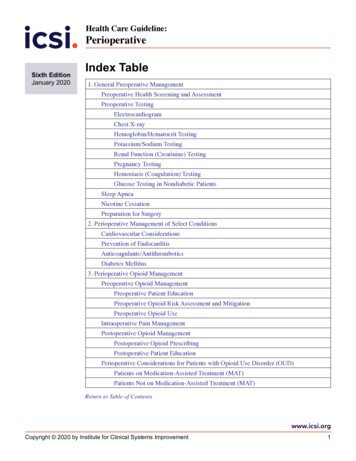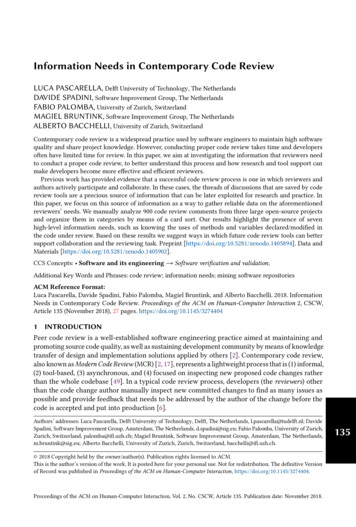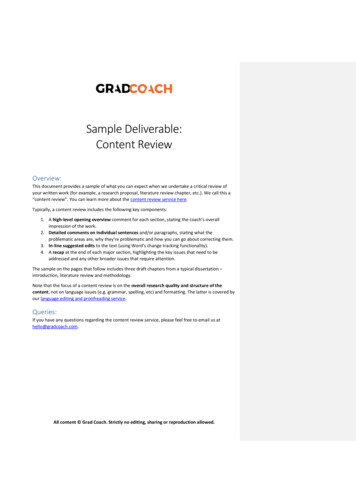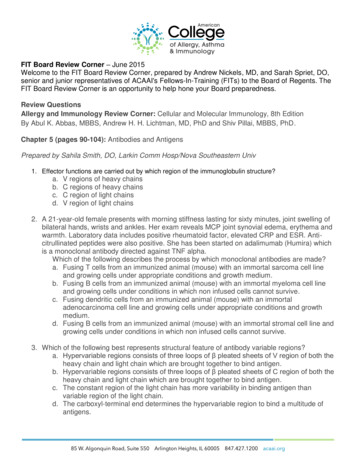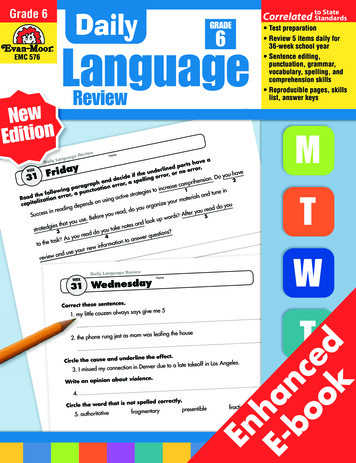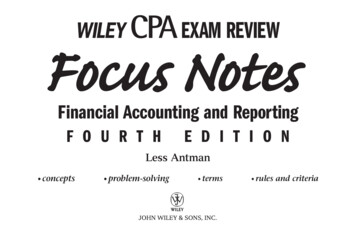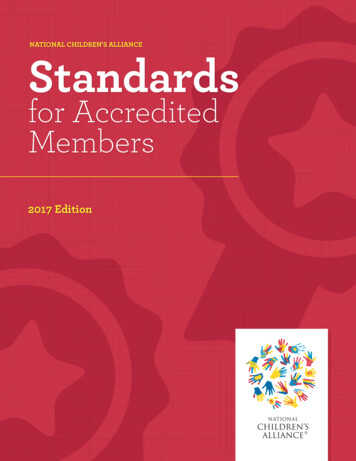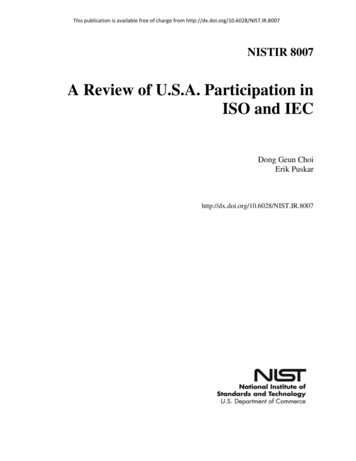
Transcription
This publication is available free of charge from http://dx.doi.org/10.6028/NIST.IR.8007NISTIR 8007A Review of U.S.A. Participation inISO and IECDong Geun ChoiErik Puskarhttp://dx.doi.org/10.6028/NIST.IR.8007
This publication is available free of charge from http://dx.doi.org/10.6028/NIST.IR.8007NISTIR 8007A Review of U.S.A. Participation inISO and IECDong Geun ChoiErik PuskarStandards Coordination OfficeLaboratory ProgramsThis publication is available free of charge from:http://dx.doi.org/10.6028/NIST.IR.8007June 2014U.S. Department of CommercePenny Pritzker, SecretaryNational Institute of Standards and TechnologyWillie May, Acting Under Secretary of Commerce for Standards and Technology and Acting Director
This publication is available free of charge from http://dx.doi.org/10.6028/NIST.IR.8007ForewordThe primary strategy for U.S.A. government engagement in standards development is “reliance onprivate sector leadership, supplemented by federal government contributions to discretestandardization processes as outlined in OMB Circular A-119, Federal Participation in theDevelopment and Use of Voluntary Consensus Standards and in Conformity Assessment Activities.”1Apart from standards development led by the private sector, the Trade Act of 1979 requires that theU.S.A. federal government shall inform, consult and coordinate with the U.S.A. Trade Representativewith respect to international standards-related activities in order to keep each adequately informed andidentify activities that may substantially affect U.S.A. commerce.Based on Section 2543 of the Trade Agreements Act of 19792, the Department of Commerce (DOC) isresponsible for monitoring the representation of United States interests before international standardsorganizations. As an agency of DOC, the National Institute of Standards and Technology (NIST)published two specific reports for this purpose. The first report, titled ‘A Review of U.S.A.Participation in International Standards Activities (NBSIR 3698)’, was published in January 1988, andcovered the U.S.A. participation status in International Organization for Standardization (ISO) andInternational Electrotechnical Commission (IEC) during 1966 to1986. The second report, ‘A Reviewof U.S.A. Participation in ISO and IEC (NISTIR 6492),’ was published 12 years later in February2000, and covered U.S.A. participation from 1966 to 1998 with a focus on the latter years. These tworeports are a few of the publicly available resources to track the history of U.S.A. participation in ISOand IEC.For the same purpose served by the two previous reports in 1988 and 2000, this report in 2014 isdesigned to describe the U.S.A. participation in ISO and IEC standardization activities during theyears 1966 to 2012. This report shows the U.S.A. memberships, secretariats, chairs, and convenors instandards development committees in ISO and IEC compared with previous years and other countries.Additionally, this report provides some data about the agreement-based cooperative activities of a fewU.S.A.-domiciled standards developing organizations. The alignment status of American NationalStandards (ANS), approved by American National Standards Institute (ANSI), with ISO and IECstandards, is also included.Disclaimer: Any mention of commercial products or organizations within this document is forinformation only; it does not imply recommendation or endorsement by NIST.KeywordsU.S.A. Trade Agreement Act; WTO; TBT; Agreement on Technical Barriers to Trade; IEC; ISO;American National Standards Institute (ANSI); international standards; participation; trade; and,1White House (January 17, 2012), Memorandum for the Heads of Executive Departments and Agencies – Principles forFederal Engagement in Standards Activities to Address National Priorities (M-12-08).2Trade Agreements Act of 1979 (Section 2533: Representation of United States interests before international standardsorganizations).ii
This publication is available free of charge from http://dx.doi.org/10.6028/NIST.IR.8007United States National Committee (USNC).Table of ContentsForeword . iiKeywords . iiTable of Contents . iiiTable of Contents – Figures.vTable of Contents – Tables .vAcronyms .vi1. Introduction .11.1 Purpose .11.2 The Role of NIST in Standards Activities.21.3 Impacts of Standards on Trade .31.4 WTO TBT Agreement.31.5 The Politics and History of International Standardization .42. Comparison with Two Previous NIST Publications .53. U.S.A. Participation in ISO .63.1 About ISO .63.2 U.S.A. Participation in ISO Technical Committees and Subcommittees .83.4. U.S.A. Leadership in ISO TCs and SCs (Jan 2012) .114. U.S.A. Participation in IEC .124.1 About IEC .124.2 U.S.A. an IEC Member Since Its Foundation in 1906 .154.3 U.S.A. Participation in IEC SCs and TCs (April 2013) .164.4 U.S.A. leadership in IEC TCs and SCs (December 2012) .184.5 U.S.A. Number of Experts and New Proposals in 2012 .195. Agreement-based Participation by U.S.A.-domiciled SDOs or Consortia .205.1 IEEE’s Partnerships with ISO and IEC .205.2 ASTM International’s Partnerships with ISO Since 1999 .225.3 Approved PAS Submitters to JTC 1, Including some US-domiciled Consortia .235.4 OGC’s Agreement with ISO/TC211 Since 1998 .24iii
This publication is available free of charge from http://dx.doi.org/10.6028/NIST.IR.80076. Use of ISO and IEC Standards in the USA .246.1 Adoption of ISO and IEC Standards as American National Standards (ANS) .246.2 Referencing ISO and IEC Standards in U.S.A. Regulations .267. Summary .277.1 Participation in ISO and IEC .277.2 Agreement-based Participation in ISO and IEC .287.3 U.S.A. Standards and Regulations Aligned with ISO and IEC Standards .29Annex 1. Membership Comparison of ISO, IEC, and UN (Dec 2012) .31Annex 2. List of ISO and IEC Technical Committees .37A2.1 List of 224 ISO Technical Committees (Dec 2012) .37A2.2 List of 97 IEC Technical Committees (Dec 2012) .43A2.3 List of Subcommittees in ISO/IEC JTC 1 and JPC 1 (Dec 2012) .47Annex 3. List of U.S.A. Secretariats in ISO and IEC .48A3.1 List of 121 ISO TC/SCs Whose Secretariat is the U.S.A. (Dec 2012) .48A3.2. List of 24 IEC TC/SCs Whose Secretariat is the U.S.A. (Dec 2012) .52Annex 4. ISO and IEC Standards Development Stages .53A4.1 Proposal Stage .53A4.2 Preparatory Stage .53A4.3 Committee Stage .53A4.4 Enquiry Stage .53A4.5 Approval Stage .54A4.6 Publication Stage .54A4.7 Review of International Standards (Confirmation, Revision, Withdrawal) .54A4.8 Fast-track Procedure .54A4.9. ISO and IEC standards development codes.55Annex 5. U.S.A. Laws Concerning NIST’s Role in Standardization .56A5.1 Trade Agreements Act of 1979 .56A5.2 The National Technology Transfer and Advancement Act (NTTAA) of 1995 .58A5.3 OMB Circular No. A-119 .58Annex 6. MOU between ANSI and NIST .59A6.1 - 1.0 Purpose .59A6.2 - 2.0 Agreement .59iv
This publication is available free of charge from http://dx.doi.org/10.6028/NIST.IR.8007A6.3 - 3.0 ANSI Responsibilities .60A6.4 - 4.0 NIST Responsibilities .60A6.5 - 5.0 Strategies .61A6.6 - 6.0 Other Agreements .61A6.7 - 7.0 Annual Meeting.61A6.8 - 8.0 Termination .61Table of Contents – FiguresFigure 1Figure 2Figure 3Figure 4Figure 5Figure 6Figure 7ISO Structure (source: www.iso.org).8IEC Structure (source: www.iec.ch) .14U.S.A. P-memberships in ISO and IEC have Increased in 1986 to 2012 .27U.S.A. Secretariats Increased in 1966-1998, and Declined in 1998 to 2012 .28U.S.A. Convenor in ISO Decreased and Chair in IEC increased in 1998 to 2012 .28Adoption of ISO and IEC Between 1986 and 2012 .29Incorporation by Reference of ISO and IEC Between 2002 and 2012 .30Table of Contents – TablesTable 1 Comparing Topics in three NIST reports (1988, 2000, and 2013).6Table 2 Top 20 Countries in ISO participation (P- and O-members) (Dec 2012) .10Table 3 ISO Secretariats and Convenors over Time (1966 to 2012) .11Table 4 Top 20 Countries Holding ISO Secretariat and Convenor Roles in 2011 .12Table 5 Number of IEC TCs and SCs as of April 2013 (source: www.iec.ch) .17Table 6 Top 20 Countries in IEC P-memberships (Dec 2012) .17Table 7 Top 15 Countries in IEC Secretariats and Chairs in Sep 2012.18Table 8 IEC Change in Secretariats held 1966 to 2012.19Table 9 Top 10 Countries in IEC Participation of Experts (2005, 2012) .19Table 10 Source of IEC New Proposals (1999, 2012) .20Table 11 List of Approved PAS Submitters to JTC 1 .23Table 12 ANS Adoption from ISO, IEC standards (1987, 1996, and 2012) .25Table 13 ISO and IEC Standards Incorporated by Reference in the U.S.A. regulations .27Table 14 Agreement-based Participation in ISO and IEC.29v
This publication is available free of charge from NYMSDESCRIPTIONS (Country or Organization)ABNTBrazilian Technical Standards Association (Brazil)AENORAsociación Española de Normalización y Certificación (Spain)AFNORAssociation française de normalisation (France)ANSAmerican National Standard (USA)ANSIAmerican National Standards Institute (USA)APIAmerican Petroleum InstituteASIAustrian Standards Institute (Austria)ASRORomanian Standards Association (Romania)ASTMASTM InternationalBECBelgian Electrotechnical Committee (Belgium)BISBureau of Indian Standards (India)BSIBritish Standards Institution (UK)CEIComitato Elettrotecnico Italiano (Italy)CESSwiss Electrotechnical Committee (Switzerland)CFRCode of Federal Regulations (USA)DINGerman Institute for Standardization (Germany)DKEDeutsche Kommission Elektrotechnik Elektronik Informationstechnik (Germany)DMTFDistributed Management Task Force, Inc.DSDanish Standards Foundation (Denmark)GOST RFederal Agency on Technical Regulating and Metrology (Russia)IECInternational Electrotechnical CommissionIEC CABIEC Conformity Assessment BoardIEC CBIEC Council BoardIEC COIEC Central OfficeIEC EXCOIEC Executive CommitteeIEC MSBIEC Market Strategy Boardvi
This publication is available free of charge from http://dx.doi.org/10.6028/NIST.IR.8007IEC NCIEC National CommitteeIEC SMBIEC Standardization Management BoardIEEEInstitute of Electrical and Electronics EngineersISOInternational Organization for StandardizationISO CASCOISO Committee on Conformity AssessmentISO COPOLCOISO Committee on Consumer PolicyISO CSISO Central SecretariatISO CSCISO Council Standing CommitteeISO DEVCOISO Committee on Developing Country MattersISO GAISO General AssemblyISO MBISO Member BodyISO PDCsISO Policy Development CommitteesISO TMBISO Technology Management BoardJISCJapanese Industrial Standards Committee (Japan)KATSKorean Agency for Technology and Standards (Korea)NBNBureau voor Normalisatie/Bureau de Normalisation (Belgium)NENNetherlands Standardization Institute (Netherlands)NISTNational Institute of Standards and Technology (USA)OASISOrganization for the Advancement of Structured Information StandardsOGCOpen Geospatial Consortium (USA)O-memberObserver Member (ISO, IEC)OMGObject Management GroupOVEOesterreichischer Verband für Elektrotechnik (Austria)PKNPolish Committee for Standardization (Poland)P-memberParticipating Member (ISO, IEC)PSDOPartner Standards Development Organization (ISO)SAStandards Australia (Australia)SABSSouth African Bureau of Standards (South Africa)SACStandardization Administration of China (China)SCSubcommittee (ISO, IEC)SCCStandards Council of Canada (Canada)vii
This publication is available free of charge from http://dx.doi.org/10.6028/NIST.IR.8007SEKSEK Svensk Elstandard (Sweden)SESKOFinnish Electrotechnical Standards Association (Finland)SFSFinnish Standards Association (Finland)SIBRStandards Incorporated by Reference (name of database , USA)SISSwedish Standards Institute (Sweden)SNStandards Norway (Norway)SNIAAdvancing Storage and Information TechnologySNVSwiss Association for Standardization (Switzerland)TATechnical Advisor (USNC for IEC)TAGTechnical Advisory Group (ANSI/USNC for ISO and IEC) (USA)TCTechnical Committee (ISO, IEC)TCGTrusted Computing GroupULUnderwriters LaboratoriesUNIEnte Nazionale Italiano di Unificazione (Italy)UNMZCzech Office for Standards, Metrology and Testing (Czech Republic)UPnP ForumUniversal Plug and Play ForumUSNCUnited States National Committee (for IEC) (USA)UTEUnion Technique de L’Electricite (France)W3CWorld Wide Web ConsortiumWGWorking Group (ISO, IEC)viii
This publication is available free of charge from http://dx.doi.org/10.6028/NIST.IR.80071. Introduction1.1 PurposeThis report presents historical information on the extent of U.S.A. participation and leadership roles in twoprivate-sector international standardization bodies, perspectives on the organizations involved, the presentrole of international standards in world trade, and the correlation between the U.S.A. position ininternational standardization activities and world trade.This publication serves as an update to the original NBSIR 88-3698, A Review of U.S.A. Participation inInternational Standards Activities, as well as NISTIR 6492, A Review of U.S.A. Participation in theInternational Organization for Standardization (ISO) and the International Electrotechnical Commission(IEC). It focuses on U.S.A. participation in technical committees (TC) and sub-committees (SC) within twoprivate-sector international standards development organizations, namely ISO and IEC. Due to the volumeof information involved, this publication does not address U.S.A. participation in any of the other activitieswithin each of these organizations (e.g., the Committee on Conformity Assessment and the Committee onConsumer Policy in ISO, conformity assessment schemes in IEC). Specific mention is also made of theWorld Trade Organization’s (WTO) Agreement on Technical Barriers to Trade. It should be noted that someU.S.A.-based standards developers have increased their international presence over this time period. TheU.S.A. involvement with these developers may be more robust and may share common goals with regards tostandards development.U.S.A. participation in private-sector international standardization activities is voluntary. Directinvolvement and payment of the associated expenses depends upon the perceived interests of the industriesthat may be affected by resultant standards. Consequently, some U.S.A. companies and industries have beenvery active in international standards-making committees, whereas others have not participated at all. Theobjective of this study was to collect, analyze, and present data that might summarize the extent of past andpresent U.S.A. participation in the activities of ISO and IEC over the 46-year period from 1966 to 2012.This information can help readers assess whether U.S.A. involvement and leadership activities are sufficientand what, if any, strategies or actions are necessary to strengthen the U.S.A. position in these organizations.The following sections describe various NIST responsibilities, the significance of international standards inworld trade, background on ISO and IEC, and how the United States is represented in those bodies.Separate sections briefly describe the WTO Agreement on Technical Barriers to Trade and Annex 3 of thatAgreement, the Code of Good Practice for the Preparation, Adoption and Application of Standards. Areview of U.S.A. participation levels in ISO and IEC over the 46-year period from 1966 to 2012 is provided,followed by a comparison of U.S.A. exports with U.S.A. participation in ISO and IEC.1
This publication is available free of charge from http://dx.doi.org/10.6028/NIST.IR.80071.2 The Role of NIST in Standards Activities3Title IV, Section 413 of the Trade Agreements Act of 1979 (19 U.S.A.C. 2531-2573), P.L. 96-39, authorizedthe implementation of all agreements negotiated during the General Agreement on Tariffs and Trade (GATT)Tokyo Round, including those relating to non-tariff barriers. Section 413 of the Act directs the Secretaries ofCommerce and Agriculture to ensure that they are kept informed of the adequacy of representation ininternational standards-related activities, to identify any activities that might substantially affect thecommerce of the United States, and to coordinate with the Special Representative (the Office of the UnitedStates Trade Representative, USTR) with respect to international standards-related activities. USTR isresponsible for coordinating U.S.A. discussions and negotiations with other countries with respect tostandards-related activities.Title IV also specifies that the U.S.A. should be represented in non-treaty or private international standardsorganizations (e.g., ISO and IEC) by a recognized “organization member.” Responsibility rests with theSecretaries of Commerce and Agriculture to determine and ensure that U.S.A. interests are being adequatelyrepresented and that U.S.A. commerce is not adversely affected by that organization member’s participationin private international standards organizations. There are no guidelines or definitions given for what isdeemed to be adequate representation of U.S.A. interests. ANSI serves as the U.S.A. member body to ISOand, through its U.S.A. National Committee, to IEC.Within NIST, the Standards Coordination Office is responsible for carrying out several Title IV functions.These include maintaining an inquiry point on standards, conducting conformity assessments and technicalregulations, and monitoring the adequacy of U.S.A. representation in private international standards activities,particularly with regard to the potential impact on international trade. The 1994 revision of the TradeAgreements Act (P.L. 103-465), also entitled the Uruguay Round Agreements Act, did not amend theseresponsibilities.In addition to its responsibilities under the Trade Agreements Act, NIST serves as a coordinator of standardsrelated activities within the federal government as directed by OMB Circular A-119, which serves asimplementation guidance for the National Technology Transfer and Advancement Act (NTTAA) of 1995(P.L. 104-113).To ensure a coordinated effort between the public and private sectors in both domestic and non-treatyinternational standards activities, NIST and ANSI signed a Memorandum of Understanding (MOU)4.Revised and renewed in 2000, this MOU states that NIST and ANSI will serve as links between privatesector standards and conformity assessment interests and government interests. The ultimate objective of thiscooperative effort is to enhance and strengthen the national voluntary consensus standards system of theUnited States while supporting continued U.S.A. competitiveness and economic growth. Other governmentagencies, U.S.A. and non-U.S.A.-based international standards developing organizations (SDOs), tradeassociations, and companies are members of ANSI. Representatives of these organizations participate invarious ANSI fora which are, in part, responsible for determining ANSI policy and structure. These fora also3The U.S. Laws concerned with NIST’s role for standardization are summarized in Annex 5.4Annex 6 contains the full text of the MOU between ANSI and NIST.2
This publication is available free of charge from http://dx.doi.org/10.6028/NIST.IR.8007serve as mechanisms that facilitate discussion of current issues of interest.1.3 Impacts of Standards on TradeStandards are more important today than ever before. In the international marketplace, standards developedthrough voluntary processes are highly desirable because they represent a broad-based consensus of allinterested parties, including producers (exporters), users (importers), governments, consumers, andacademia. Nations that actively participate in developing international standards may be able to influence theprovisions to favor their own products or those that they prefer for some reason. Since trading countriescompeting in the global marketplace are inclined to be aggressive in exploiting every opportunity to favorthese products through the standards development process, it seems incumbent on the United States toparticipate vigorously in international standardization activities if it intends to maintain existing trade outletsand find new markets.1.4 WTO TBT AgreementThe provisions of the Agreement on Technical Barriers to Trade (TBT Agreement) and of the Code of GoodPractice for the Adoption, Application and Preparation of Standards (Code) have important implications forISO and IEC member bodies.Specific provisions under the TBT Agreement pertain to technical regulations, standards, conformityassessment practices, notification requirements, and standards developing bodies. In the area of technicalregulations and standards, the TBT Agreement states that members should: accord the same treatment to imported products as like products of national origin;accord the same treatment to all like imported products, regardless of origin;ensure that any technical regulations and standards used to protect human, animal, or plant life orhealth or the environment are not more trade-restrictive than necessary;use, in part or in whole, relevant international standards as a basis for technical regulationswhenever possible;participate in relevant international standards bodies to develop and adopt appropriate technicalregulations and standards;recognize technical regulations of other members as equivalent provided these regulations meet theobjectives of their own regulations;emphasize product performance requirements rather than design or descriptive requirements, andnotify other members of proposed technical regulations and standards that might significantly affecttrade.Annex 3 of the TBT Agreement contains the Code. The Code is open to acceptance by any standardizingbody within the territory of a WTO Member and outlines general guidelines for the preparation and use ofstandards. The Code encourages standards bodies to operate in a transparent manner, ensurenondiscrimination toward imported products, and align national standards with international standardswhenever possible. Adoption of the Code is voluntary, but more than 100 standards bodies currently adhereto the Code. In the United States, ANSI is a signatory to the Code on behalf of its over 200 standards3
This publication is available free of charge from http://dx.doi.org/10.6028/NIST.IR.8007developing members.1.5 The Politics and History of International StandardizationInternational trade is one of the most important factors in the growth of the world economy. Importantobjectives of international standardization and related activities are to facilitate trade and the exchange ofgoods and services at the international level and to promote cooperation in the areas affected by internationalstandards.Formal international standardization started over one hundred years ago in the electrotechnical field with thefounding of the IEC in 1906. While some attempts were made in the 1930s to develop internationalstandards in other fields, it was not until after World War II that the United Nations Standards CoordinatingCommittee, established by the United States, Great Britain, and Canada, provided the leadership thatresulted in the formation of ISO in 1946.During the 1950s and 1960s, international standardization work focused almost entirely on the developmentof international agreements on basic mechanics, such as screw threads, roller bearings, pipe sizes, shafts,couplings, and power transmissions. These early efforts addressed issues primarily related to internationalharmonization for interchangeability, vocabularies, a
U.S.A.-domiciled standards developing organizations. The alignment status of American National Standards (ANS), approved by American National Standards Institute (ANSI), with ISO and IEC standards, is also included. Disclaimer: Any mention of commercial products or organizations within this document is for




